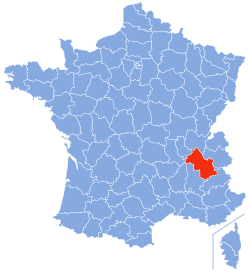Isère
| Isère | ||
|---|---|---|
| Department | ||
|
Prefecture building of the Isère department, in Grenoble | ||
| ||
 Location of Isère in France | ||
| Coordinates: 45°20′N 05°30′E / 45.333°N 5.500°ECoordinates: 45°20′N 05°30′E / 45.333°N 5.500°E | ||
| Country | France | |
| Region | Auvergne-Rhône-Alpes | |
| Prefecture | Grenoble | |
| Subprefectures |
La Tour-du-Pin Vienne | |
| Government | ||
| • President of the General Council | André Vallini | |
| Area1 | ||
| • Total | 7,431 km2 (2,869 sq mi) | |
| Elevation | 846 m (2,776 ft) | |
| Highest elevation | 4,088 m (13,412 ft) | |
| Lowest elevation | 134 m (440 ft) | |
| Population (2012) | ||
| • Total | 1,224,993 | |
| • Rank | 16th | |
| • Density | 160/km2 (430/sq mi) | |
| Time zone | CET (UTC+1) | |
| • Summer (DST) | CEST (UTC+2) | |
| Department number | 38 | |
| Arrondissements | 3 | |
| Cantons | 29 | |
| Communes | 533 | |
| ^1 French Land Register data, which exclude estuaries, and lakes, ponds, and glaciers larger than 1 km2 | ||
Isère (French pronunciation: [izɛːʁ]; Arpitan: Isera, Occitan: Isèra) is a department in the Auvergne-Rhône-Alpes region in the east of France named after the river Isère.
History
Isère is one of the original 83 departments created during the French Revolution on March 4, 1790. It was created from part of the former province of Dauphiné.[1] Its area has been reduced twice, in 1852 and again in 1967, on both occasions losing territory to the department of Rhône.
In 1852 in response to rapid urban development round the edge of Lyon, the (hitherto Isère) communes of Bron, Vaulx-en-Velin, Vénissieux and Villeurbanne were transferred to Rhône.[2] In 1967 the redrawing of local government borders led to the creation of the Urban Community of Lyon (more recently known simply as Greater Lyon / Grand Lyon). At that time intercommunal groupings of this nature were not permitted to straddle departmental frontiers, and accordingly 23 more Isère communes (along with 6 communes from Ain) found themselves transferred to Rhône. The affected Isère communes were Chaponnay, Chassieu, Communay, Corbas, Décines-Charpieu, Feyzin, Genas, Jonage, Jons, Marennes, Meyzieu, Mions, Pusignan, Saint-Bonnet-de-Mure, Saint-Laurent-de-Mure, Saint-Pierre-de-Chandieu, Saint-Priest, Saint-Symphorien-d'Ozon, Sérézin-du-Rhône, Simandres, Solaize, Ternay and Toussieu.
Most recently, on 1 April 1971, Colombier-Saugnieu was lost to Rhône. Banners appeared in the commune's three little villages at the time proclaiming "Dauphinois toujours" (Always Dauphinois)
Isère was also the name of the French ship which delivered the 214 boxes holding the Statue of Liberty.
Geography
Isère is part of the current region of Auvergne-Rhône-Alpes and is surrounded by the departments of Rhône, Ain, Savoie, Hautes-Alpes, Drôme, Ardèche, and Loire.
Isère includes a part of the French Alps. The highest point in the department is the Sub-Peak "Pic Lory" at 4,088 metres, subsidiary to the Barre des Écrins. The summit of La Meije at 3,988 metres is also very known. The Vercors Plateau dominates the west of the department.
Demographics
Inhabitants of the department are called Isérois.
Politics
The President of the General Council is André Vallini of the Socialist Party.
| Party | seats | |
|---|---|---|
| • | Socialist Party | 24 |
| Union for a Popular Movement | 14 | |
| Miscellaneous Right | 7 | |
| • | French Communist Party | 6 |
| • | Miscellaneous Left | 4 |
| • | The Greens | 3 |
Culture
The Grande Chartreuse is the mother abbey of the Carthusian order. It is located 14 miles north of Grenoble.
As early as the 13th century, residents of the north and central parts of Isère spoke a dialect of the Franco-Provençal language called Dauphinois. It continued to be spoken in rural areas of Isère into the 20th century.
Tourism
Isère features many ski resorts, including the Alpe d'Huez, Les Deux Alpes, the 1968 Winter Olympics resorts of Chamrousse, Villard de Lans, Autrans. Other popular resorts include Les 7 Laux, Le Collet d'Allevard, Méaudre, Saint-Pierre-de-Chartreuse, Alpe du Grand Serre, Gresse-en-Vercors.
Grenoble has a dozen museums, including the most famous created in Grenoble in 1798, the Museum of Grenoble.
It is the third largest ski and winter destination of France, after Savoie and Haute-Savoie, and before Hautes-Alpes. It also hosts Coupe Icare, an annual festival of free flight, such as paragliding and hang-gliding, held at the world-renowned paragliding site at Lumbin.
-

The Grand Veymont
-

The Dent de Crolles
-

Queyras valley
Miscellaneous topics
Poma (ski-lifts) and Rossignol (ski and winter surf company) are headquartered in Isère, near Grenoble.
Other companies include STMicroelectronics France, Schneider Electric SA, Caterpillar France SAS, Hewlett Packard, Becton Dickinson France SAS, Soitec, Siemens, Teisseire.
Isère produces the following cheeses: Bleu du Vercors-Sassenage, an Appellation d'Origine Contrôlée cheese, and Saint-Marcellin.
See also
- Cantons of the Isère department
- Communes of the Isère department
- Arrondissements of the Isère department
References
- ↑ Frederick Converse Beach; George Edwin Rines (1912). The Americana: a universal reference library, comprising the arts and sciences, literature, history, biography, geography, commerce, etc., of the world. Scientific American compiling department. p. 741.
- ↑ Revue du Lyonnais (in French). L. Boitel. 1865. p. 197.
|

